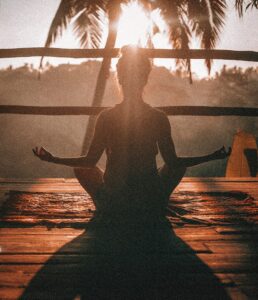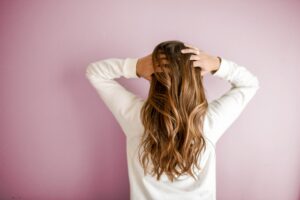What Causes Damaged Hair And 10 Tips To Naturally Repair It

- What Is Damaged Hair?
- 10 Tips To Naturally Repair Your Damaged Hair
- 1. Avoid Heat Damage
- 2. Avoid Chemical Treatments
- 3. Hair Mask
- 4. Relax
- 5. Leave-In Conditioner
- 6. Avoid Harsh Ingredients
- 7. Anti-Breakage Keratin Oil Shampoo
- 8. Change Your Hairstyle
- 9. At Home Oil Treatment
- 10. Change How You Dry Your Hair
- Conclusion
If you’ve ever experienced having damaged hair, you’ll know that it’s no fun. The hair feels dry and brittle and if you run your fingers through it, they’ll likely get stuck at some point because your hair gets easily knotted. You may also find that your hair is prone to breakages, you have split ends and the color has dulled. A pretty dismal prognosis for anyone.
If you can relate to the above description of damaged hair, I truly feel for you. I suffered from damaged hair not so long ago which is why I’m here to discuss this all-important topic. I hope to inspire you through sharing my journey of how I went from dry, damaged and thinning hair to regaining my natural, thick, healthy hair. Yes, miracles do happen. So, don’t give up on your hair just yet. There is hope.
What Is Damaged Hair?

Damaged hair knots easily.
Many people think they have damaged hair, and since it’s very easy to damage our hair, many people are correct. There are a few factors that Healthy hair should have and elasticity is one of them. Your hair should bounce back if you tug at it. You know it’s brittle hair if it breaks when you pull at it. Split Ends is another telltale sign of damaged hair. The ends of your hair shafts will look and feel dry and damaged when they have split into fragments. This could either mean that all your hair is damaged, or it can occur over time to the tips of your hair which are older. If you are noticing that the top of your head is full and healthy and the tips are dry and brittle, this means that you have split ends and should trim your hair to prevent your hair from knotting and from sustaining further damage. Frizzy hair can be caused by high porosity. Damaged hair is more porous than healthy hair. Therefore damaged hair will absorb moisture and chemicals more quickly and easily than healthy hair, which will make your hair frizzy.
It’s normal for curly hair to be naturally drier than straight hair, but if your straight hair is dry and brittle, you’ve probably got damaged hair. If you’re a curly-haired girl and wondering how you can distinguish dry hair from damaged hair, pay attention to the level of dryness. Having hair that is dry with no moisture whatsoever and prone to breakages, your hair is more likely to be damaged rather than dry. If you’re constantly getting knots, then you most likely have damaged hair. Knots are caused by split ends and dry and brittle hair.
10 Tips To Naturally Repair Your Damaged Hair

Straightening your hair leads to dry and split ends.
1. Avoid Heat Damage
There’s a famous Youtube video where a young girl accidentally burns off her hair using a curling iron. It’s very entertaining because of her honest shock, but it also shows the dangers of using heating tools. Blow dryers, flat irons, curling irons can all cause a serious disruption in your hair care regime. I learned this the hard way. For a year, I regularly ironed my hair straight. I realized the grave mistake I’d made a little too late. The regular exposure to intense heat caused major hair damage. It made my hair dry and brittle. Depending on your hair type, hot tools may not damage your hair that quickly, but it eventually will if you don’t protect it the right way. You should avoid heat styling if you can and let your hair air dry. Everything is okay in moderation. As you may already know, a hot air brush could, in fact, help your hair!
2. Avoid Chemical Treatments

Using chemicals in your hair may cause damage.
Perms or chemical treatments of any type, including bleach, can do more harm than help. Your hairstylist or colorist won’t tell you the amount of damage they’re causing you. But, chemicals cause hair breakages and dry out your hair. Hair dye needs to break through your hair cuticles (your hair’s natural protection) in order for it to set permanently. Once the ammonia in hair dye lifts the hair cuticles, the peroxide in hair dye works to strip away your natural hair color so that a new color can be deposited onto your hair. The longer this process takes, and your cuticle is exposed, the more damaged your hair will sustain.
3. Hair Mask
When treating damaged hair, a hair mask is always a good option. A good combination for the perfect hair mask is olive oil and avocado. Being that olive oil is full of omega-3 fatty acids means that it’s great for hair growth. The avocado works so well because it contains proteins and amino acids acting as a moisturizer. All you need to do is mix 2 tablespoons of olive oil with a ripe avocado and add a little hydrating honey for the perfect hair mask. Leave your hair covered in a shower cap for thirty minutes to an hour to make your hair look shiny and flyaway free.
4. Relax

Finding ways to relax may help with reduce hair damage.
Not only can stress cause hair loss, but stress can also cause damaged hair, breakages, and even worse, dandruff. Stress can lead to telogen effluvium which makes your hair follicles go dormant causing hair that’s in the middle of a hair cycle to break off. There are many other hair issues that can be caused by stress, like alopecia areata and trichotillomania. Therefore, it’s important for you to stress less. It would also be beneficial for you to learn relaxation techniques. There are deep breathing exercises, yoga, and meditation. All are great options to bring your stress and anxiety levels down. You also shouldn’t feel ashamed to seek out help from a professional. Having someone (like a therapist) to talk to is a great resource to make you feel better.
5. Leave-In Conditioner
Leave-in conditioner is typically used on damp hair after shampooing and conditioning your hair before styling. Whether you plan to use a hair dryer or let your hair air dry, a leave-in conditioner can help many different hair types. If your hair is damaged, dry, frizzy, or all in one, it can add much-needed moisture. It makes hair easier to style and shinier. You can make a leave-in conditioner at home. When it comes to products, natural is always better, which is why a DIY leave-in conditioner would be great. Combine 1-ounce coconut oil, 2 ounces aloe vera gel and 1 teaspoon avocado oil with 1/3 cup of water. Put the mixture into a spray bottle and spray away on your just-washed hair. You may need to warm up the bottle a bit since coconut oil is solid at room temperature.
6. Avoid Harsh Ingredients

Sulfates can irritate the skin and scalp.
You may have noticed hair products increasingly being advertised as silicone-free. Silicon has received a bad rap for having negative side effects on your hair. It gives the hair a plastic coat, giving your hair the illusion of being healthy and shiny when, in reality, the plastic coat blocks moisture and nutrients from entering the hair shaft. Silicon lends your hair a short-term appearance of being healthy and shiny before the lack of moisture in your hair weakens your hair, making it dry, brittle, prone to breakages, dull and lifeless. Sulfates are chemical detergents that work a little too effectively. They remove the dirt and oil from your hair together with your hair’s natural moisture that keeps it healthy. Sulfates may also contain traces of the carcinogen, dioxane. Frequently using shampoos with sulfates can be harsh on your hair, eventually leading to damage. Products containing formaldehyde faced a lot of consumer backlash recently. Formaldehyde is a carcinogen and may increase the risk of several other diseases. We should all avoid shampoos containing this ingredient, not only those of us with damaged hair.
7. Anti-Breakage Keratin Oil Shampoo
Keratin-infused products and keratin smoothing hair treatments have been all the buzz lately. The protein is known for combating frizz and revitalizing and repairing damaged hair. Don’t feel like shelling out a few hundred for a salon keratin treatment for your damaged hair? Not to worry, you can pick up keratin oil shampoos at your local drug store for an affordable price. Look for a shampoo that’s sulfate-free with keratin and Argan oil to repair and hydrate damaged hair. Natural oils, such as argan oil, coconut oil, jojoba oil, macadamia oil, and almond oil, hydrate your hair. Nourishing your hair removes some of the dryness, preventing hair breakages and further damage to your hair. Keratin It’s probably THE most important ingredient to look for in shampoos for damaged hair. Natural oils and moisturizing ingredients will hydrate your hair and may improve the appearance of damaged hair, but they won’t repair damaged hair the same way keratin can.
Many people confuse damaged hair with dry hair and vice versa. They are two very different things. Dry hair needs moisture while damaged hair needs protein. Keratin is a protein that makes up the outer layer of our skin, our nails, and our hair. Damaged hair reflects a loss in essential proteins. Using a shampoo infused with keratin proteins can help rebuild the protein structure of damaged hair, working to repair the hair. You should also look for a product with glycerine since it protects the hair from further damage and retains moisture in your hair.
8. Change Your Hairstyle

wearing your hair in tight hairstyles can be causing damage.
If you’re constantly wearing a hairstyle that pulls on your hair like a tight ponytail, braids, or cornrows, you’re probably causing damage. You probably will notice thinning around your part or your part widening. The best way to deal with this is to change the location of your part. Brushing your hair too often can cause split ends and breakages. The constant tugging, pulling, and weight on your hair can even cause permanent damage which is why it’s important to act quickly. Putting your hair up when it’s wet can also damage your tresses. Your wet hair is weaker than your hair when it’s dry, so you should be extra careful.
9. At Home Oil Treatment
At-Home oil treatments are as effective or even more effective than a deep conditioner. Washing your hair too frequently can weaken your hair and suck out the natural oils from your hair. Dry shampoo is, therefore, a great option to use in between washes. Olive oil is a great oil to use for oil treatment. It’s been used as a hair conditioner for a while. It delivers a dose of omega-3 fatty acids and antioxidants to help restore strength and make it shine. It contains squalane as well. Squalane is great for nurturing skin and hair. All you need to do is warm up half a cup of oil and make sure it doesn’t boil. Massage the warm oil into your hair and use a shower cap to cover it. Wrap a towel around your head to keep the heat insulated. Leave the oil for 45 minutes before you rinse it out with shampoo. This technique is literally putting the moisture back into your hair.
10. Change How You Dry Your Hair
The way you’re drying your hair could very well be causing damage. You’re probably even using the wrong type of towel. It’s recommended to use a microfiber one or a T-shirt. A standard towel will be too abrasive for drying your locks. If you choose to let your hair air dry, you may think that you’re avoiding all problems but you may not. If your hair takes a long time to dry, your hair will be porous for too long. The swelling of wet hair puts pressure on the proteins that keep your strands together and strong. You also may feel pressured to brush your wet hair, but wet hair is weak which means your brush may cause breakage. If you want to blow dry your hair, you should use the cool setting instead of the hot one. It may take longer but blasting your hair with heat is never a good idea.
Conclusion
So, that’s it. The low down and everything you need to know about taking care of your damaged hair. There’s no reason to neglect damaged hair when there are so many fantastic products available to treat it. I guess with the advent of styling tools that cause heat damage, we’ve had to introduce products like keratin proteins to counteract the widespread unhealthy hair practices.
With the increasing number of shampoos designed to treat damaged hair, I still believe prevention is the key when it comes to damaged hair. If you have damaged hair, it’s never too late to start being kind to your hair. Pick up a repairing shampoo at your local drug store and consider embracing your natural tresses and hair color, because over coloring your hair and heat damage are among the top causes for damaged hair.

